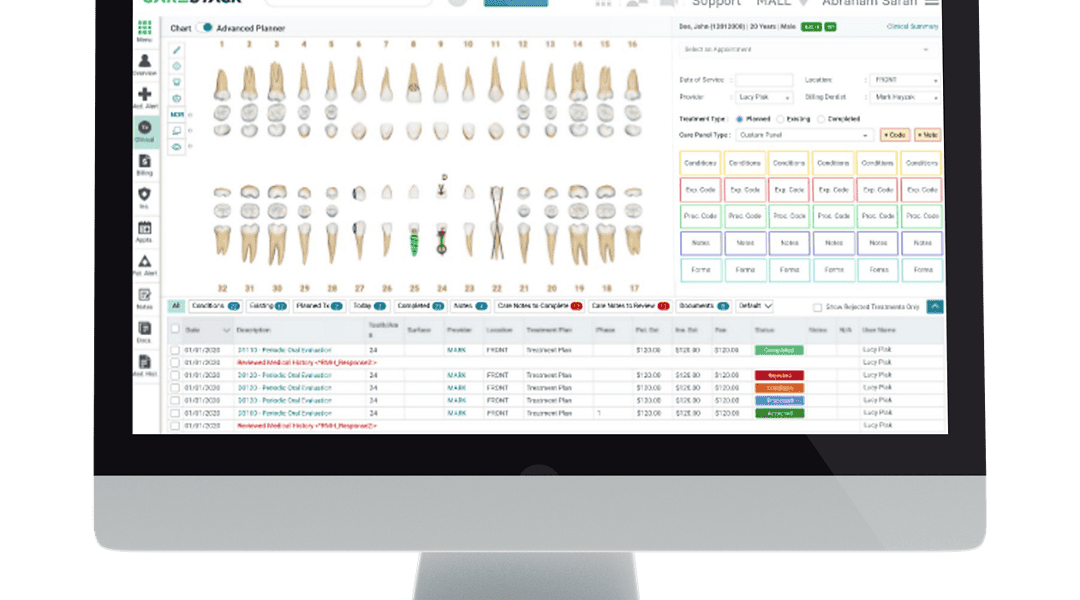The dental industry is experiencing a digital revolution, with advanced software solutions transforming both patient care and practice management. From artificial intelligence (AI) to cloud-based systems, modern dental software is enhancing efficiency, accuracy, and patient experience. As technology continues to evolve, dental practices must stay ahead by adopting these innovations to remain competitive and provide superior care.
This article explores the future of dental software, focusing on key innovations that are reshaping the industry.
1. Artificial Intelligence and Machine Learning
AI and machine learning are revolutionizing dental diagnostics and treatment planning. AI-powered imaging software can detect cavities, fractures, and other oral health issues with greater accuracy than traditional methods. For example, AI-driven radiographic analysis can help dentists identify early signs of periodontal disease, allowing for proactive treatment.
Machine learning algorithms can also predict treatment outcomes based on patient history, guiding dentists toward more effective care plans. Additionally, AI chatbots and virtual assistants are enhancing patient communication, answering common queries, and automating appointment scheduling.
2. Cloud-Based Dental Software for Enhanced Accessibility
Cloud-based solutions are becoming a game-changer for dental practices, offering seamless access to patient records and management tools from any location. Unlike traditional on-premise systems, cloud-based dental software enables real-time collaboration between dental professionals, improving workflow efficiency.
Key benefits of cloud-based dental software include:
– Remote access: Dentists can view patient records from anywhere, facilitating better communication and decision-making.
– Data security: Cloud platforms offer encrypted storage and regular backups, reducing the risk of data loss.
– Scalability: Practices can easily expand their software capabilities without investing in expensive hardware upgrades.
3. Teledentistry: Expanding Patient Access to Care
Teledentistry is gaining popularity as an innovative way to provide remote consultations, making dental care more accessible to patients in rural or underserved areas. Through video conferencing and digital imaging tools, dentists can assess patient concerns, provide preliminary diagnoses, and recommend treatments without requiring an in-person visit.
This advancement is particularly beneficial for follow-up appointments, post-surgical check-ins, and minor consultations, reducing unnecessary clinic visits while improving convenience for patients.
4. Integration of Digital Imaging and 3D Printing
Advancements in digital imaging and 3D printing are significantly impacting dental software capabilities. Intraoral scanners, CBCT (Cone Beam Computed Tomography), and digital impressions are now seamlessly integrated with dental software, allowing for precise treatment planning.
3D printing, powered by CAD/CAM (Computer-Aided Design and Computer-Aided Manufacturing) software, enables dentists to create custom dental restorations such as crowns, bridges, and dentures in-house. This not only reduces turnaround time but also ensures a better fit and improved patient satisfaction.
5. Automation and Workflow Optimization
Modern dental software is automating routine administrative tasks, freeing up valuable time for dentists and staff. Automated appointment scheduling, patient reminders, and billing systems streamline practice management, reducing errors and improving efficiency.
Some key automation features include:
– AI-driven scheduling: Optimizes appointment slots to minimize gaps and maximize productivity.
– Electronic Health Records (EHR) integration: Ensures seamless access to patient history, treatment plans, and prescriptions.
– Automated billing and insurance claims: Reduces paperwork and speeds up reimbursement processes.
6. Enhanced Patient Experience Through Digital Tools
Patient experience is at the core of modern dental software innovations. With mobile apps, online portals, and virtual consultations, patients have greater control over their oral health.
Some notable patient-focused features include:
– Self-service portals: Allow patients to book appointments, access treatment plans, and view billing statements online.
– Virtual treatment simulations: Help patients visualize potential outcomes before undergoing procedures.
– AI-driven oral health tracking: Personalized reminders and recommendations for at-home dental care.
7. Blockchain for Secure Patient Data Management
Blockchain technology is emerging as a secure solution for managing patient records and transactions. By decentralizing data storage and using cryptographic encryption, blockchain ensures that patient information remains tamper-proof and easily accessible to authorized personnel.
This technology can also streamline insurance claims and payment processes, reducing fraud and improving transparency between patients, providers, and insurers.
8. The Rise of Smart Dental Devices
Smart dental devices, such as AI-powered toothbrushes and wearable oral health trackers, are integrating with dental software to provide real-time insights into patient habits. These devices collect data on brushing techniques, plaque buildup, and gum health, which can be shared with dentists for personalized recommendations.
For instance, some smart toothbrushes use sensors to analyze brushing patterns and offer feedback via mobile apps, helping patients maintain better oral hygiene between visits.
The future of dental software is driven by innovation, making dentistry more precise, efficient, and patient-centric. AI-powered diagnostics, cloud-based solutions, teledentistry, and automation are streamlining practice management while enhancing patient care. Additionally, technologies like blockchain and smart devices are setting new standards for security and personalization in dental healthcare.
As these advancements continue to evolve, dental professionals who embrace cutting-edge software solutions will be better positioned to improve patient outcomes and optimize practice operations. The key to success lies in staying informed and integrating the right technologies to meet both current and future demands in dentistry.

